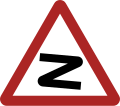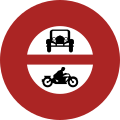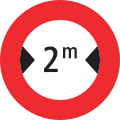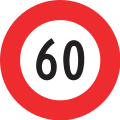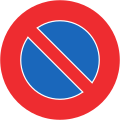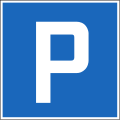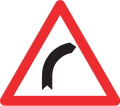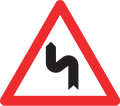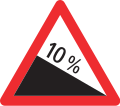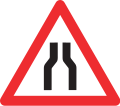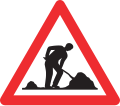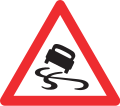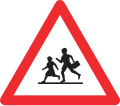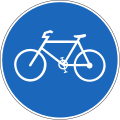Illustration of the road signals in Switzerland and Liechtenstein from 1932 to 1963
The picture table of the road signals in Switzerland from 1932 to 1963 and in Liechtenstein from 1936 to 1963 shows the signals as laid down in the ordinance on road signaling of October 17, 1932 . This signaling catalog came into force on December 1, 1932 and was valid until the amendment to the ordinance on August 1, 1963 (see picture table of road signals from 1963 to 1979 ).
Before 1932, the cantons in Switzerland were responsible for motor vehicles and thus for road signaling. The cantons had harmonized motor vehicle and bicycle traffic in intercantonal concordats of June 13, 1904, April 7, 1914 and December 29, 1921. In 1925, all cantons with the exception of Obwalden, Nidwalden, Glarus, Zug and Graubünden had joined the Concordat. In 1932, road traffic became a federal matter and the federal law on motor vehicle and bicycle traffic was introduced. It repealed the Concordats and contradicting cantonal provisions became ineffective. Liechtenstein adopted the Swiss federal law by analogy with the law of 3 July 1933 regarding the (sic!) Enactment of new provisions on traffic on public roads and paths (traffic regulations) .
The ordinance on road signaling was created in the course of the Swiss law . Any earlier signals issued by cantons, municipalities or private individuals before 1932 that contradicted the ordinance had to be removed or replaced by 1935. In Liechtenstein the reference date was August 1, 1936. Liechtenstein adopted the Swiss catalog on May 1, 1936.
The signals have been divided into triangular danger signals, round regulation signals and rectangular information signals (Art. 2). The colors “signal red” and “signal blue” were defined. The back had to be gray (Appendix B, Section II. Colors). The signals had to be illuminated, have reflectors or otherwise be visible through the light cone of the car even in adverse weather conditions (Articles 15–16).
At construction sites, the danger signal no. 6 “Other dangers” was used on interurban roads, in urban areas - if necessary - the warning signal no. 22 “Caution” was used (Art. 9, Paragraph 4 and Art. 14, Paragraph 2). The place-name signs all had a blue background (Art. 14 Para. 3), a distinction between main roads signaled in blue and secondary roads signaled in white only existed in the case of signpost signals (signals No. 24 a and b, cf. also Art. 4 Federal Council resolution on the main roads Right of priority from March 26, 1934 ) The other signals, if they are still used today, have roughly the same meaning.
The following catalog was valid as of 1932, although there are differences compared to 1963 and later, especially in the font, dimensions and silhouettes (some of the current ones are shown below):
Signalization catalog, status 1932
Danger signals
- Danger signals
No. 1: transverse channel
Regulation signals
- Regulation signals
The end of a stretch of road with a maximum speed is indicated by a vertical, black stripe on the gray back of the signal (Art. 11, Paragraph 3).
Warning signals
- Warning signals
Subsequent changes and additions to the road signals
Note: Due to the lack of sources, not all adjustments are presented in full at the moment. In 1963, for example, signals such as “ 231 no parking ” or “ 219 drive around obstacle on the right ” were not considered new at that time, so they must have been known before 1963.
November 22, 1934
With a Federal Council resolution of November 23, 1934, the layout of the signals for guarded and unguarded level crossings was adjusted in line with the international agreement on motor vehicle traffic concluded in Paris on April 24, 1926.
Until 1934, a level crossing was considered guarded if it was “marked with barriers or with optical and acoustic signals”, which meant that a level crossing was considered guarded even if the surveillance was only visual and acoustic. This was adjusted with a resolution, since then a level crossing is only considered guarded if it is provided with barriers.
- Level crossings
June 12, 1936
In the Federal Council resolution on wagon traffic on mountain post roads of June 12, 1936 , signals of the mountain post roads were defined.
- New releases in 1936
July 9, 1946
With the Federal Council decision of July 9, 1946, the following signal was added:
- Launched in 1946
June 28, 1949 (AS 1949 547)
On June 28, 1949 it was decided to introduce the stop signal on July 15, 1949.
- Launched in 1949
March 15, 1953 (AS 1953 101)
With the Federal Council resolution on the introduction of new road signals of March 3, 1953, the following signals were newly introduced on March 15, 1953. This introduction corresponded to the present minutes of the European Transport Conference, which met from March 18, 1953 in Paris. This first post-war conference was based on the consideration that the transport system of the Western European countries had to be revised due to the reorganization of the world situation and the increasing traffic.
Earlier signals with the same meaning have been replaced and no longer set up again.
- New launches in 1953
Art. 3: Dangerous gradient
June 1, 1959 (AS 1959 445)
In connection with the introduction of the maximum urban speed of 60 km / h, two new signals were defined as part of the Federal Council resolution on the maximum speed of motor vehicles of May 8, 1959 , which came into force on June 1, 1959:
- New launches in 1959
In contrast to the law applicable today, the place-name signs had an influence on the maximum speed - analogous to what is the case today in Germany: 60 km / h was valid from the place-name sign, and this restriction was lifted from the end of the place-name sign (Art. 1 Para. 1– 2 Federal Council resolution on the maximum speed of motor vehicles of May 8, 1959). If these are missing, the driver must act independently in the case of “densely built-up areas” or speed signs have been set up.
Individual evidence
- ↑ Ordinance on road signaling of October 17, 1932 (Adjusted Collection 1947, Volume 7, page 693ff.)
- ↑ Ordinance on road signaling of May 31, 1963 (AS 1963 541, i.e. on page 541ff, in PDF page 9ff.)
- ↑ From the concrete stand to the LED signal . In: Verkehrshaus der Schweiz (Ed.): Verkehrshaus-Magazin . No. 29 , July 2017, p. 8th f . ( verkehrshaus.ch [PDF; accessed on September 13, 2017]). From the concrete stand to the LED signal ( Memento of the original from September 14, 2017 in the Internet Archive ) Info: The archive link has been inserted automatically and has not yet been checked. Please check the original and archive link according to the instructions and then remove this notice.
- ↑ Art. 72 Federal Law on Motor Vehicle and Bicycle Traffic of March 15, 1932
- ↑ Federal Act on Motor Vehicle and Bicycle Traffic of March 15, 1932 (Adjusted Collection 1947, Volume 7, page 595ff.)
- ↑ Liechtensteinisches Landesgesetzblatt: 1933 No. 10
- ↑ Federal Council resolution on the replacement of road signals of January 29, 1935 (adjusted collection 1947, volume 7, page 705f.)
- ↑ a b Liechtensteinisches Landesgesetzblatt: 1936 No. 9 : Ordinance of April 27, 1936 on road signaling
- ↑ Federal Council resolution on the main roads with right of way of March 26, 1934 (adjusted collection 1947, volume 7, page 706f.)
- ↑ Federal Council resolution regarding the amendment of Art. 9, Para. 2 and 3 of the ordinance of October 17, 1932 on road signaling. (Pages 5-6)
- ↑ Federal Council resolution on wagon traffic on mountain post roads of June 12, 1936 (adjusted collection 1947, volume 7, page 715ff.). It should be noted that this resolution repeals a Federal Council resolution of June 9, 1933, but it is not in the revised collection.
- ↑ Ordinance on road signaling of October 17, 1932 (adjusted collection 1947, volume 7, page 703, footnote 1)
- ↑ Federal Council resolution regarding the amendment of the ordinance on road signaling of June 28, 1949 (AS 1949 547, in PDF page 9ff)
- ↑ Federal Council resolution on the introduction of new road signals of March 3, 1953 (AS 1953 101)
- ↑ Federal Council resolution on the maximum speed of motor vehicles of 8 May 1959 (AS 1959 445, in the PDF page 11ff.)


